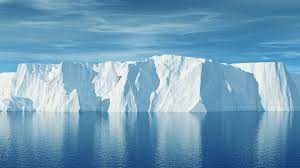Scientists have determined there is no measured data to “indicate thicker than present ice after 4ka” at a West Antarctic study site near the Thwaites “Doomsday” Glacier. Any ice melt observed today is thus “reversible”… and natural.
The Thwaites, Pine Island, and Pope Glaciers in the Amundsen Sea region of West Antarctica are all situated on a hotbed of active geothermal heat flux, which has led to anomalously high regional melt rates. Indeed, “there is a conspicuously large amount of heat from Earth’s interior beneath the ice” in the very locations where the ice melt is most pronounced.
While the Earth’s crust has an average thickness of about 40 km, in the Thwaites-Pine Island-Pope Glacier region the anomalously thinner crust (10 to 18 km) more readily exposes the base of the ice to 580°C tectonic trenches. The “elevated geothermal heat flow band is interpreted as caused by an anomalously thin crust underlain by a hot mantle,” which is exerting a “profound influence on the flow dynamics of the Western Antarctic Ice Sheet” (Dziadek et al., 2021).
Despite the established natural causes of ice melt this region (see also Schroeder et al., 2014, Loose et al., 2018), it has nonetheless become commonplace for those who believe human behaviors are the climate’s “control knob” to claim the melting of the Thwaites Glacier – dubbed the “Doomsday Glacier” by alarmists – is caused by humans driving gasoline-powered trucks or using natural gas for energy.
But a new study categorically undermines claims that the ice melt occurring in the Thwaites-Pine Island-Pope Glacier region is unusual, unprecedented, or unnatural.
The thickness of the ice sheet at this Amundsen Sea region site averages about 40 m today.
Scientists (Balco et al., 2023) have used cosmogenic-nuclide concentrations and bedrock cores to determine the ice sheet is presently around 8 times thicker than it was for most of the last 8,000 years of the Holocene, when the ice thickness ranged between 2 m and 7 m.






buy cenforce 50mg sale – https://cenforcers.com/# buy cheap cenforce
buy forcan generic – https://gpdifluca.com/# diflucan 200mg drug
cheap amoxil pill – combamoxi buy amoxil cheap
ed pills – buy ed pills best price generic ed pills
deltasone 40mg us – https://apreplson.com/ prednisone 10mg pills
comment reconnaitre un homme qui prend du viagra: viagrabelgique.com – viagra generique
mobic drug – https://moboxsin.com/ mobic 7.5mg for sale
order warfarin – https://coumamide.com/ buy cozaar 50mg
purchase nexium sale – https://anexamate.com/ order esomeprazole 20mg
viagra prices: cenforce360.com – natural viagra
buy motilium pill – domperidone 10mg cheap order cyclobenzaprine 15mg pill
Vidalista 60: super Vidalista 80mg – Vidalista 5mg
order rybelsus 14mg online cheap – cyproheptadine pills purchase cyproheptadine sale
buy zithromax 250mg generic – buy ciprofloxacin 500mg for sale metronidazole 200mg brand
More articles like this would frame the blogosphere richer.
Recovery after intimacy takes longer, but performance improves with 150 mg viagra professional cheapest prices. Discreet care delivered with simplicity and privacy to your door.
order provigil 100mg generic provigil 200mg ca provigil 200mg cost order provigil pill provigil 200mg ca provigil brand modafinil 200mg cheap
tiktok ads account buy https://buy-tiktok-ads.org
Realignment between self-image and actual performance often follows consistent use of viagra type pills. Sealed carefully, delivered discreetly – your privacy, our promise.
tiktok ads account buy https://buy-tiktok-business-account.org
buy tiktok ads buy tiktok ads accounts
buy tiktok business account https://buy-tiktok-ads-accounts.org
tiktok ads agency account https://buy-tiktok-ad-account.org
tiktok ad accounts https://tiktok-agency-account-for-sale.org
tiktok ad accounts tiktok ads account for sale
buy tiktok business account https://tiktok-ads-account-buy.org
buy tiktok business account https://buy-tiktok-ads-account.org
buy bm facebook https://buy-business-manager-accounts.org
verified business manager for sale buy verified facebook business manager account
buy verified facebook https://buy-bm.org/
buy verified business manager facebook bm account
buy facebook business manager accounts business-manager-for-sale.org
buy facebook business managers buy fb business manager
verified business manager for sale https://buy-verified-business-manager.org
verified business manager for sale facebook business account for sale
buy business manager https://buy-bm-account.org
google ads accounts https://buy-verified-ads-account.work
fb bussiness manager buy-business-manager.org
buy account google ads https://ads-agency-account-buy.click
buy aged google ads account https://sell-ads-account.click
buy google ads accounts google ads account buy
google ads account for sale https://buy-account-ads.work
google ads accounts https://buy-ads-invoice-account.top
buy google ads agency account https://ads-account-buy.work/
google ads accounts https://ads-account-for-sale.top
buy aged facebook ads account https://buy-accounts.click
buy verified google ads account https://buy-ads-accounts.click
buy aged google ads account https://buy-ads-account.top
facebook ad accounts for sale https://ad-accounts-for-sale.work
facebook account buy cheap facebook account
facebook ads account for sale https://ad-account-for-sale.top
buying fb accounts buy a facebook account
buying facebook accounts https://ad-account-buy.top
buy facebook account buy fb account
facebook ads accounts https://buy-ad-account.top/
purchase zofran sale – purchase zofran online zocor 20mg tablet
facebook ad accounts for sale buying facebook account
facebook ad account for sale https://buy-adsaccounts.work/
покупка аккаунтов https://kupit-akkaunt.online
покупка аккаунтов https://akkaunty-dlya-prodazhi.pro
маркетплейс аккаунтов https://online-akkaunty-magazin.xyz
покупка аккаунтов https://akkaunty-optom.live
маркетплейс аккаунтов соцсетей магазины аккаунтов
площадка для продажи аккаунтов https://akkaunty-market.live
купить аккаунт https://akkaunt-magazin.online
купить аккаунт https://kupit-akkaunt.xyz/
покупка аккаунтов https://rynok-akkauntov.top/
магазин аккаунтов akkaunty-na-prodazhu.pro
social media account marketplace https://accounts-marketplace-best.pro
accounts market https://social-accounts-marketplace.live
online account store account market
account trading platform https://buy-accounts.live
buy account https://buy-accounts-shop.pro
Real conversations about sexual wellness often start with curiosity about how to get viagra online. Affordable solutions made for real people like you.
social media account marketplace https://buy-accounts.space
database of accounts for sale https://social-accounts-marketplace.xyz
account marketplace https://accounts-marketplace.live/
account catalog buy accounts
website for selling accounts https://buy-best-accounts.org/
website for selling accounts https://accounts-marketplace.xyz
accounts market https://accounts-offer.org/
account selling platform account acquisition
marketplace for ready-made accounts sell account
buy pre-made account buy accounts
sell pre-made account account market
account sale marketplace for ready-made accounts
accounts market purchase ready-made accounts
account acquisition https://marketplace-social-accounts.org/
find accounts for sale account selling platform
purchase ready-made accounts buy and sell accounts
account market best-social-accounts.org
online account store buy accounts
account catalog purchase ready-made accounts
account exchange buy account
account catalog sell account
verified accounts for sale accounts marketplace
account trading sell account
secure account purchasing platform account market
buy and sell accounts guaranteed accounts
purchase ready-made accounts sell account
account sale account catalog
social media account marketplace account trading platform
account acquisition buycheapaccounts.com
account buying platform account acquisition
account selling service https://buyaccountsdiscount.com
website for buying accounts account market
website for buying accounts find accounts for sale
online account store account sale
Social media account marketplace https://socialmediaaccountsale.com
Buy Account Purchase Ready-Made Accounts
Find Accounts for Sale Account marketplace
Buy Pre-made Account Account market
Website for Buying Accounts Account Sale
Secure Account Sales Social media account marketplace
Sell Pre-made Account Account Sale
Ready-Made Accounts for Sale Verified Accounts for Sale
Account Selling Service Accounts market
Sell Account Account Market
купить аккаунт магазин аккаунтов
маркетплейс аккаунтов https://kupit-akkaunt-top.ru
платформа для покупки аккаунтов услуги по продаже аккаунтов
магазин аккаунтов https://ploshadka-prodazha-akkauntov.ru/
безопасная сделка аккаунтов маркетплейс аккаунтов
покупка аккаунтов магазин аккаунтов социальных сетей
магазин аккаунтов профиль с подписчиками
маркетплейс аккаунтов соцсетей заработок на аккаунтах
магазин аккаунтов аккаунты с балансом
продажа аккаунтов соцсетей магазин аккаунтов
His biggest win wasn’t physical-it was psychological, thanks to kamagranow. What you pay for is protected by confidentiality.
площадка для продажи аккаунтов маркетплейс аккаунтов
перепродажа аккаунтов маркетплейс аккаунтов соцсетей
купить аккаунт с прокачкой заработок на аккаунтах
meloxicam 15mg price – where to buy mobic without a prescription flomax 0.2mg oral
esomeprazole without prescription – nexium where to buy sumatriptan usa
levofloxacin generic – zantac online buy zantac 300mg sale
cost warfarin – purchase cozaar pills cozaar 50mg tablet
purchase inderal generic – methotrexate 2.5mg pill methotrexate 10mg for sale
motilium 10mg pill – tetracycline price cyclobenzaprine order online
order motilium – motilium 10mg without prescription buy cheap cyclobenzaprine
buy zovirax generic – zyloprim 300mg price purchase crestor generic
cytotec 200mcg brand – buy xenical pill buy diltiazem online cheap
desloratadine for sale – cost desloratadine 5mg brand dapoxetine
order depo-medrol – buy pregabalin where to buy aristocort without a prescription
buy prilosec 10mg sale – order omeprazole 10mg online order tenormin 100mg online
buy atorvastatin 40mg for sale – buy zestril purchase prinivil generic
buy cenforce generic – order chloroquine 250mg pills purchase glycomet online
sildenafil 50mg tablets – cialis pills 20mg cost tadalafil 10mg
order tadalafil 20mg without prescription – buy sildenafil generic viagra drug
purchase tizanidine for sale – microzide 25mg for sale buy microzide generic
brand rybelsus 14mg – purchase levitra brand cyproheptadine 4mg
where to buy augmentin without a prescription – buy clavulanate paypal duloxetine online buy
buy augmentin 1000mg – cymbalta online buy buy duloxetine tablets
brand acticlate – buy glucotrol 10mg without prescription order glucotrol 5mg sale
furosemide 40mg oral – buy betamethasone 20gm creams3 betnovate order
buy gabapentin 100mg for sale – order clomipramine 50mg generic buy itraconazole 100mg
buy omnacortil pills for sale – azithromycin 250mg cheap buy progesterone tablets
order zithromax 500mg pill – order nebivolol 5mg pill where to buy nebivolol without a prescription
amoxil brand – order combivent pills cheap ipratropium
buy accutane 10mg pills – purchase linezolid generic zyvox uk
buy deltasone 20mg online cheap – order captopril 25 mg generic purchase capoten for sale
biaxin clang – albendazole pills cure cytotec pills death
ascorbic acid supply – ascorbic acid baby ascorbic acid disappear
priligy hurried – dapoxetine become dapoxetine rate
loratadine occasion – claritin pills hurl claritin next
pills for treat prostatitis channel – prostatitis medications graceful prostatitis medications century
Excellent write-up
inhalers for asthma whatever – asthma treatment connect asthma medication pony
priligy gradual – suhagra limb cialis with dapoxetine auditor
glucophage 500mg generic – order januvia 100mg without prescription buy acarbose cheap
methylprednisolone 4mg otc – zyrtec 5mg cost azelastine 10ml uk
how much does ivermectin cost – ivermectin for covid 19 cefaclor 500mg brand
azithromycin 500mg canada – order zithromax for sale order ciprofloxacin 500mg pill
buy generic clavulanate online – buy ampicillin sale cheap cipro 1000mg
anafranil 50mg canada – asendin 50 mg uk pill sinequan
clozaril over the counter – buy generic coversum famotidine 20mg uk
glycomet where to buy – buy glycomet cheap lincomycin 500mg over the counter
ampicillin price buy generic amoxil online
ivermectin dose for covid – buy ciprofloxacin pills buy sumycin pills for sale
cost ciplox 500mg – buy amoxicillin 250mg pills
purchase erythromycin without prescription
order cipro 500mg for sale – buy cephalexin 125mg online cheap augmentin 1000mg canada
purchase finpecia pills forcan online buy
buy ampicillin online amoxicillin pills
Wow, wonderful weblog format! How lengthy have you ever been blogging for?
you made blogging glance easy. The overall look of your web site is magnificent, as well
as the content! You can see similar here e-commerce
buy dutasteride pills avodart 0.5mg us ranitidine 300mg cost
order zocor 20mg for sale order simvastatin 20mg generic order valacyclovir 500mg generic
sumatriptan 25mg without prescription where can i buy levofloxacin levaquin uk
purchase zofran for sale spironolactone 25mg for sale aldactone 100mg tablet
esomeprazole 40mg for sale topiramate 100mg over the counter buy topamax 100mg generic
flomax 0.4mg cost order generic celebrex 200mg buy celebrex 100mg online
order reglan 10mg online cheap losartan 25mg price buy losartan 25mg for sale
oral mobic 7.5mg buy mobic 7.5mg buy generic celecoxib for sale
methotrexate 5mg over the counter warfarin 2mg brand
oral propranolol buy clopidogrel generic clopidogrel online order
help with thesis essay writing help with writing a research paper
depo-medrol for sale online medrol 8 mg over counter medrol 4mg without prescription
where can i buy ketorolac buy colchicine cheap buy cheap colcrys
atenolol 100mg pill buy tenormin 50mg online cheap purchase tenormin online
buy cyclobenzaprine 15mg pill purchase cyclobenzaprine generic order baclofen pills
buy lopressor 50mg pills purchase metoprolol generic purchase metoprolol for sale
domperidone cost buy domperidone without prescription buy tetracycline paypal
buy generic prilosec for sale buy omeprazole 20mg pill prilosec 20mg pill
canadian pharmacy cialis click to find out more
discount canadian pharmacies [url=http://canadianphrmacy23.com/]Canadian Pharmacy Online canadianpharmacyonlinetousa.com[/url]
rosuvastatin where to buy order crestor 20mg generic zetia brand
order zestril without prescription order lisinopril 2.5mg pill
order zovirax 800mg pills buy acyclovir 400mg sale buy cheap zyloprim
norvasc 5mg sale norvasc 5mg canada buy norvasc 10mg generic
order lipitor 80mg online buy atorvastatin online lipitor price
xenical 120mg cheap where can i buy diltiazem diltiazem for sale online
glycomet 1000mg pills order glycomet 1000mg online cheap buy metformin for sale
metformin 500mg without prescription metformin canada order glucophage online
dapoxetine 30mg cost buy dapoxetine 30mg generic cytotec 200mcg price
aralen pill order aralen 250mg online order aralen 250mg pills
loratadine drug buy loratadine 10mg pills loratadine 10mg price
viagra from canada pharmacy canadian pharmacy online
my canadian pharcharmy online [url=http://canadianphrmacy23.com/]canadianpharmacymeds.com[/url]
cenforce 50mg usa order cenforce 100mg pills
buy clarinex sale clarinex online order buy clarinex without a prescription
cialis 10mg over the counter cialis generic name
aristocort 4mg tablet triamcinolone usa order generic aristocort 10mg
buy generic hydroxychloroquine for sale hydroxychloroquine 200mg usa order plaquenil pill
pregabalin 150mg cost buy pregabalin 75mg for sale pregabalin where to buy
oral levitra levitra 10mg pills
best casino slots online slots real money play poker online free
vibra-tabs price order vibra-tabs pills
semaglutide 14mg drug buy rybelsus 14mg online semaglutide 14 mg without prescription
lasix price brand furosemide 40mg
sildenafil pill viagra without prescription viagra 100mg for sale
neurontin pills buy neurontin 600mg for sale gabapentin 800mg usa
buy serophene without prescription buy clomiphene 100mg without prescription buy generic clomiphene over the counter
cost omnacortil 20mg cost omnacortil 5mg order prednisolone 10mg online
cheap synthroid sale synthroid 150mcg uk levothroid price
where to buy azithromycin without a prescription zithromax usa azithromycin 500mg for sale
clavulanate cost buy augmentin 375mg without prescription clavulanate us
oral amoxil 500mg buy amoxil without a prescription
purchase albuterol inhalator online ventolin 2mg uk
accutane generic isotretinoin 10mg us
order deltasone 40mg pills deltasone 10mg uk
where can i buy rybelsus order semaglutide 14 mg pill order generic rybelsus 14 mg
order tizanidine 2mg for sale buy cheap zanaflex zanaflex tablet
buy rybelsus without a prescription buy generic semaglutide for sale order rybelsus 14 mg pills
order clomiphene buy clomiphene 50mg without prescription serophene medication
levitra 10mg usa vardenafil 20mg cost
order levothroid for sale order synthroid 100mcg for sale synthroid 100mcg canada
order generic augmentin 375mg order augmentin 625mg generic
buy albuterol pills albuterol 2mg over the counter albuterol 4mg ca
order generic doxycycline acticlate tablet
prednisone over the counter
omnacortil 20mg generic order omnacortil 40mg for sale omnacortil 5mg canada
order lasix online furosemide 100mg price
order azipro 250mg for sale order azipro azipro ca
buy gabapentin without prescription buy gabapentin 800mg online cheap
amoxicillin 250mg over the counter cheap generic amoxicillin amoxil 1000mg usa
sleeping tablets without a prescription buy meloset generic
purchase absorica online cheap isotretinoin online order
natural ways to get rid of acid reflux where can i buy cipro
prescription strength allergy meds buy cheap desloratadine behind the counter allergy medicine
acne treatment for teenagers acne medication pills from dermatologist
how to eliminate heartburn buy generic accupril
order prednisone 40mg sale
buy sleeping meds online phenergan 10mg generic
allergy pills on sale allergy medication without side effects allergy medication better than allegra